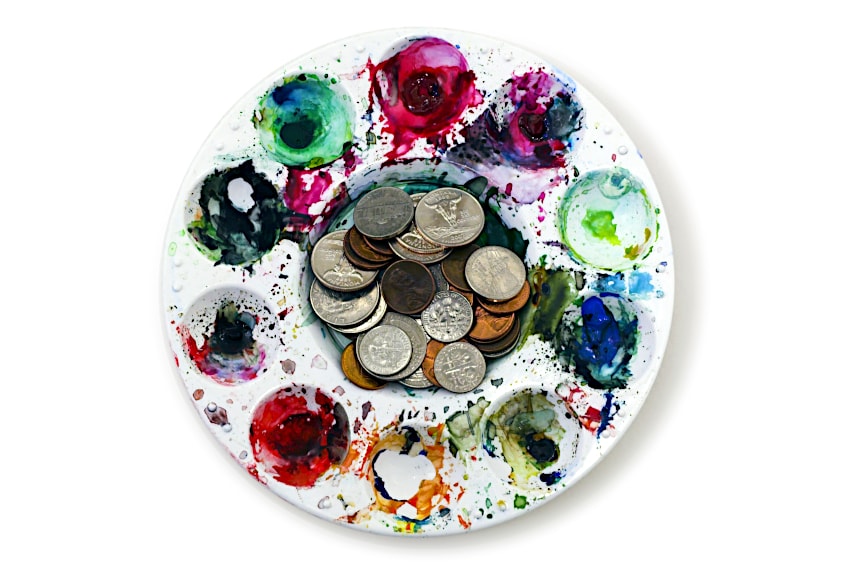How to Price Your Art – An Easy Artist’s Pricing Guide
One of the biggest struggles for an upcoming artist is how to price your art. Besides the difficulty that creatives have valuing themselves, many art schools omit the actual sales part of being an artist in their training programs. This article serves as an art pricing guide and covers the basics of what you need to consider when deciding, for example, how to price oil paintings, sculptures, photographs, and any kind of creative product.
How to Price Your Art
Since the end of the World Wars, art has gone through an interesting market shift. Power and access to money changed. Where before the wars, artists had patrons to support their endeavors, they now found themselves fending for themselves. This left them with more freedom to create what they wanted to as well as explore none traditional media such as performance art.
The rise of conceptual art followed these shifts and nowadays we find ourselves in a world where the borders around what makes something art are blurrier than ever.
The value of art no longer solely depends on the technical skill and training of the artist. The idea behind an art piece, how it resonates with the buyer, and the market environment in which an artist tries to sell their work have more of an impact than ever before.
This is clear in the sales of artworks like “The Comedian” (2019) by Maurizio Cattelan.
The idea behind this artwork, which consisted of a banana duct taped to a wall, was sold for $120,000. The buyer received a different banana than the one first exhibited, some duct-tap and instructions on how to install the artwork on a wall.
This sale clearly reflects the arbitrary nature with which artworks are ascribed prices today. It also gives us insight into why artists find it so difficult to decide on prices for their work. Artists often make many mistakes at the beginning of their careers when it comes to pricing. This is natural and acceptable as it leads to growing and learning from experience. There are, however, a few things artists can consider when entering the art world that could help them find the appropriate market at the right time.
Working on believing in your worth as a creative, considering the time spent, materials used, labor put in, and the specific market you want to enter as well as the scalability of your prices is important to take into account in understanding how to price your art.
Your Artistic Worth
Most children, whether creatively inclined or not, are often taught from a young age that they cannot make money out of an art career. This is not true, as there are many artists around the world that live off what they create. However, this lesson is often so deeply instilled in creatives that most of the mistakes they make around pricing relate to them not believing other people value their work.
If you are an artist considering how to price your acrylic paintings, for example, consider reading one of our other articles, Why Art Is Important, first before returning to this art pricing guide. Only a few of art’s most important values are listed in this article, but it could make you feel a little more confident in calling yourself an artist. It is important for each artist to arrive at a secure personal reason for why they make art and then value it personally before they expect others to value it. It is extremely important for you to believe in the value your art will add to buyers’ lives if you seriously want to make a business out of your art.
When artists do not believe that they add value to others’ lives they often give their art away for free, get exploited, or undercharge to such an extent that their art business is not scalable (we will discuss this concept later in the article).
Art Pricing Guide
How to price your art depends on many variables. The first step is to define your market and decide if you are going to sell your work internationally, regionally, locally, or nationally. You can ask yourself whether you want to be considered a fine artist or a commercial artist, for example. This will influence your prices as commercial artists often make multiple prints of their original works of art and sell them in bulk.
Secondly, you need to define the kind of art you make.
Consider the physical characteristics, the ways in which it is similar to other art, and how it is categorized. If you want to know how to price a painting, ask yourself what kind of painting it is. Consider the medium, subject matter, art style, and how you would describe the painting. This will come in handy when you look for other artists to compare yourself with in terms of pricing.
Thirdly, you need to pay attention to the kinds of artists, artworks, and prices in the market you choose to sell in. Read on their websites, visit their shows and ask them questions if you are able to. Try to find out how they make their work, how long it takes them to make it and if they are willing to share this information, how they decide on prices. Pay particular attention to artists that have similar training, experience, and resumés to you. You can make notes on artists you aspire to be like, but focus on those that fit the criteria you currently fall under.
Even though you are focusing on those artists and artworks that are similar to yours, do not dismiss the rest of the art world entirely. Keep the bigger picture in mind as well, so you make sure you price your artworks to be sold under a broad set of circumstances.
Below we have compiled a clear art pricing guide on different kinds of sales you can make, considering the time you spent creating the art piece, the labor, material costs, profit margin, and extra costs involved in selling your art.
Understanding Sales
Now that you have reached a place where you can confidently negotiate the sale of your artworks, you need to research different ways you can sell your art. We will only briefly look at gallery sales, studio sales, and commissions to see how pricing your work can change depending on the kind of sale you make.
Gallery Sales
Galleries take a percentage commission from your final selling price. This is important to take into account as you need to make sure that you are happy with the total you will receive after this percentage is deducted. Working out your prices will therefore have to include a commission margin of 35-50%.
Often, gallerists will encourage emerging artists to bump up their prices when they first start exhibiting. You need to be wary of increasing your prices too much, as it might influence the scalability of your work.
Scalability means that you price your art at the beginning of your career at accessible prices that will allow you to enter the market easily. You still need to cover your costs and include a commission margin, but you will keep your profit margin low so that an audience and community can get to know you first. Then, slowly over the years, you will gradually up your prices so as to not outprice yourself too quickly.
If you get an opportunity to be signed by a gallery or win a competition that puts you on the map as a “big name” artist, the scaling of your prices will adjust according to the exposure to buyers and collectors you get.
At the beginning of your career as a selling artist, you can decide on the absolute lowest price you are willing to sell your work for without being heartbroken when it sells. You need to consider the sustainability of your prices and might have to have more income streams to sustain you while you slowly scale your prices. You can raise your prices throughout your career, but should never lower them. If everything you are making is selling you can consider a 10-20% increase.
This way, people that missed out on the works that sold in your last show, can still afford to buy them even with the slight increase.
Studio Sales
If you are represented by a gallery or regularly exhibit with a specific gallery you will have to make sure your agreement with them allows you to sell directly to clients from your studio. Your studio price needs to be the same as your gallery price, as selling directly for less could compromise your professional integrity and complicate your relationship with galleries.
Galleries often drop artist clients if they find out that they have lowered their prices when selling from their studios.
However, because your final price already includes a commission percentage, you can use this as a little negotiation window. For example, you could offer the buyer free shipping and use the commission percentage that would have gone to a gallery to cover that cost. Or you could offer a discount of 10-20% if the buyer purchases a series of works.
Be discreet about your pricing and make sure you honor agreements you have with any third-party sellers of your work.
The reason many artists do not list their prices on their website or catalogs is that they want to honor their partner galleries while still having the flexibility to give small discounts on studio sales. Consider adding a “request prices” button on your website or social media before publishing your prices to the world.
You should also always first give the collector buying from your studio the gallery price and see if they are hesitant before mentioning free shipping or slight discounts.
Commissions
Artworks created for commissions are special request artworks made specifically for the buyer. You can add a slightly higher amount for labor or profit as you will take out special time to focus solely on the specific commission request as well as do the paperwork and admin involved in the sale if done directly with the buyer. That being said, do not quote commissions too high as it could discourage these requests. Commissions are a good way to encourage buyers to still buy your art even if they do not like any of your finished paintings available for sale.
Research Other Artists’ Prices
After considering how and where you would like to sell your work, it is a good idea to research artists that make similar work as you, that are at the same place in their career, and work with galleries you would like to work with. This should give you a good estimate of what buyers and collectors are willing to pay for your kind of art.
If you are wondering how to price a painting, it is valuable to look at other artists that paint and compare pricing oil paintings versus how to price acrylic paintings.
Looking at these artists’ supporting materials like their websites, catalogs, and social media will also give you an idea of their professional integrity and where you might have to add a bit more to reach similar prices.
Be aware of out-pricing yourself. Getting to know the artists that work in your field and media will keep you informed on how their prices scale over time and which opportunities could lead to you raising your prices faster without compromising your scalability.
Considering Time and Labor
Some art consultants would argue that collectors are buying a finished art piece and should not be charged for the time it took to create the work. There is a big debate about this element of pricing. But we believe that neglecting to consider the time and effort you have put into your work could result in an art practice that is not a sustainable business. That being said, an artist’s time is a difficult element to review as they often work months on a piece before they are willing to sell it. However, if you have an hourly guide and have done research on what other similar artists charge, you can keep yourself accountable to not overwork an art piece.
Working out an hourly rate for yourself is a good idea as it will also give you direction on how to price your time spent creating art commissions or in-person paintings like murals. In the US the average hourly rate for a fine artist is about $25, you can use this as an estimate. Include all the other cost considerations and then compare your calculated price with other artists like you.
If the price is way too high, you can bring down your hourly rate for finished paintings, or adjust them according to the different pieces (as some paintings might be created really fast and others might take more time to develop).
For example, if your materials cost $60, you take 10 hours to make the artwork, and you want to pay yourself $25 an hour to make it, then your price would be $310 ($25 x 10 hours + $60 material cost) – this is a basic price that excludes a profit, commission and extra costs margin.
If you are unwilling to change the number of hours you spend creating, even if it does not make sense financially, you can choose to simply add a set labor few to each painting and scale that amount by the size of the work. Later in your career, your hourly rate or set labor fee will increase if your name becomes known in the art world and you have had more achievements that add to the value of the work you create.
Considering Materials
The materials you use to create your works should be covered by the selling price of your art. This includes the mediums like oil, acrylic, watercolor paint, canvas, primer, and so on. But it also includes the rent you pay for your studio, the WiFi, utilities, transport costs, and subscriptions for design programs, for example. Every single cost that is required for you to produce an artwork should be listed and taken into account. We recommend you create a spreadsheet that lists these costs and work out a total monthly materials expense.
This expense can then be divided by the number of artworks created that month, or proportionally calculated by artwork.
The material consideration might influence the mediums you choose to work with at the beginning of your career as you will have to spend money to make the artworks even before you know if they will sell. That is why artists often get investors to kickstart their careers or save money from a part-time job to cover the initial expenses.
Considering Extra Costs
Extra costs might have to be taken into account if you are selling works directly from your studio or work with galleries that expect the artist to frame and wrap the artworks themselves. Researching framing, wrapping, shipping, and insurance costs is an important step in pricing your work.
If you want to sell all your artworks framed, you should include this expense in your total price.
At the beginning of your career, we do not recommend this, as many collectors often reframe work after they bought it to suit their personal style. Instead, you can offer buyers the option of framing the work through you and potentially negotiate a discount from a specific framer by committing to do your studio framing only through them.
If you are shipping your works internationally, you might want to make a note on your website or catalog that shipping will be quoted separately with each purchase, or could include a capped amount your studio is willing to cover for shipping. For example, you could say that you will cover 20% of the shipping fees or $25 maximum.
Considering Profit
Now that you have taken all the basic and extra expenses into account, you can consider profit. This is the percentage you will scale as you become more known as a selling artist. This is also where the demand and availability of the work come in. At the beginning of your career, you might have to live off the labor/hourly fee alone, but slowly you should increase that amount and add a small percentage of profit as well.
You can consider how many pieces you have made in a specific style, medium, and subject matter, the popularity of these pieces and whether the series is limited. All of these elements add to the desirability of the work and the success you will have at selling them. Keep this in mind, but also be consistent with your pricing.
For example, if you normally paint and then create one limited series where you stitch into the paintings with needle and thread, you can charge slightly higher so these special works.
Be Aware of the Following
Pricing your work can be an emotional and uncertain experience. Make sure you are aware of the following pitfall when deciding on prices. This will ensure a professional and consistent pricing experience.
Do Not Get Too Emotional About the Work You Want to Sell
This is the business aspect of your work as an artist and even though a specific painting might be really close to your heart, you cannot price it higher than others similar in size and medium. Pricing oil paintings, for example, should be different from how you price acrylic paintings, even if you feel like the subject matter and impact of the work is the same.
This is where your research of the art market will help, as you will quickly notice trends and rules in how mediums are valued differently.
Do Not Limit Yourself With the Pricing of Your Art
You have to take the market into account. Even though you might want to sell your art to an international market, you need to consider how you will be exposed to that market. If you are working with an agent that can generate interest in your work internationally, you can look at prices that will suit that market.
But otherwise, your networking skills in your immediate area will often lead to sales faster and, therefore, you should consider the accessibility of your prices to your local art buying market.
Do Not Forget to Compare Prices With Those of Other Artists
After you have worked out all your costs and included labor/time, shipping, framing, and so on and your price is way above other artists that create similar work to you, you might have to relook your profit margin and extra costs.
It is better to start at a place where you will actually sell your work than overreach and have artworks stacked up in your studio for years.
Do Not Give Art Away for Free
This is an extremely important point as artists often compromise their own value by gifting their art to family members and friends that could have been buyers. At the beginning of your career, your immediate community is often your main supporter. For example, if someone you know is interested in hanging your art in their office, but cannot afford to buy it, you can consider creating a professional agreement with them.
Set up a short contract that says you will lend the art piece to them if you can put up a label with the name, price, and medium specifications as well as a short bio next to the art piece. Make sure the agreement touches on damages or theft of your work while it is under their care. You can look at examples of simple consignment agreements with galleries to give you an idea of what this contract could look like.
This way, you can get exposure and there is a contract and time-limited connection to the agreement you have with the friend.
Considering the kind of sale, material, labor, and extra costs are a worthwhile exercise for an artist to go through when deciding how to price your art. However, pricing your art is still a personal and intuitive process. Artists should decide on prices they feel comfortable with and that fit the market they want to enter. From there they can price art accordingly and slowly scale their work as they become more known.
Frequently Asked Questions
How to Price Acrylic Paintings?
When pricing 2D works you can consider using the square inch × dollar amount formula. This involves calculating the square inches of a painting by multiplying the width by the length of the work. Then, you can work out an hourly/labor amount that fits your reputation and credentials. Keep this amount low if you are an upcoming artist and increase it slowly throughout your career. It might be helpful when coming up with this amount to price an art piece intuitively with a price you feel comfortable with and then work backward from there. Lastly, you double the cost of your materials and add it to the amount calculated before. You double your material costs to cover the 50% commission galleries usually take for selling your art. Therefore, if you are not selling with a gallery, do not double your material costs.
Why Is Pricing Oil Paintings Different From Pricing Other Paintings?
Oil paint is more expensive than acrylic, watercolor, or gouache paint. Since it is not water-soluble, you need to use painting agents to dilute oil paint. Oil paintings need to be primed with special primers as well as sealed after the painting is done. All of this adds to the material cost of oil paintings. These paintings also take longer to make as it takes longer to dry and therefore the labor/hourly rate of an oil painter will be higher than that of most acrylic painters, for example.
How to Price Your Prints?
If you are considering being a commercial artist, creating digital prints of your original artworks could be a good idea to generate extra income and make your artworks accessible to different markets. You need to add scanning and printing to your material costs. However, these editions should be cheaper than the original artworks so your hourly/labor rate needs to be much lower if you are using the square-inch × dollar amount formula.
Nicolene Burger is a South African multi-media artist, working primarily in oil paint and performance art. She received her BA (Visual Arts) from Stellenbosch University in 2017. In 2018, Burger showed in Masan, South Korea as part of the Rhizome Artist Residency. She was selected to take part in the 2019 ICA Live Art Workshop, receiving training from art experts all around the world. In 2019 Burger opened her first solo exhibition of paintings titled, Painted Mantras, at GUS Gallery and facilitated a group collaboration project titled, Take Flight, selected to be part of Infecting the City Live Art Festival. At the moment, Nicolene is completing a practice-based master’s degree in Theatre and Performance at the University of Cape Town.
In 2020, Nicolene created a series of ZOOM performances with Lumkile Mzayiya called, Evoked?. These performances led her to create exclusive performances from her home in 2021 to accommodate the mid-pandemic audience. She also started focusing more on the sustainability of creative practices in the last 3 years and now offers creative coaching sessions to artists of all kinds. By sharing what she has learned from a 10-year practice, Burger hopes to relay more directly the sense of vulnerability with which she makes art and the core belief to her practice: Art is an immensely important and powerful bridge of communication that can offer understanding, healing and connection.
Nicolene writes our blog posts on art history with an emphasis on renowned artists and contemporary art. She also writes in the field of art industry. Her extensive artistic background and her studies in Fine and Studio Arts contribute to her expertise in the field.
Learn more about Nicolene Burger and the Art in Context Team.
Cite this Article
Nicolene, Burger, “How to Price Your Art – An Easy Artist’s Pricing Guide.” Art in Context. September 19, 2022. URL: https://artincontext.org/how-to-price-your-art/
Burger, N. (2022, 19 September). How to Price Your Art – An Easy Artist’s Pricing Guide. Art in Context. https://artincontext.org/how-to-price-your-art/
Burger, Nicolene. “How to Price Your Art – An Easy Artist’s Pricing Guide.” Art in Context, September 19, 2022. https://artincontext.org/how-to-price-your-art/.





























